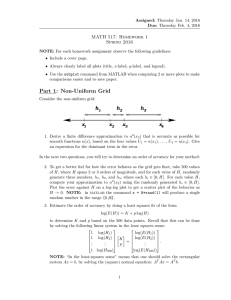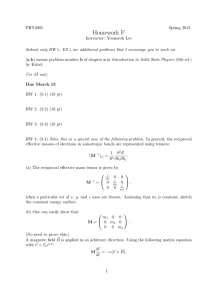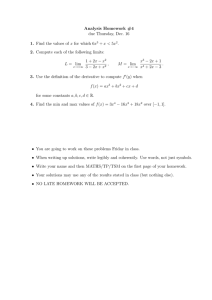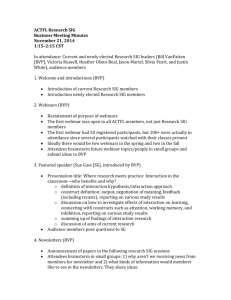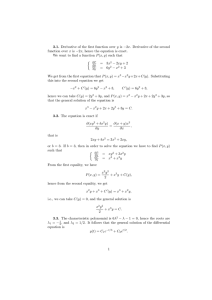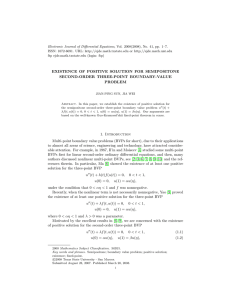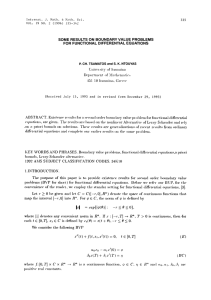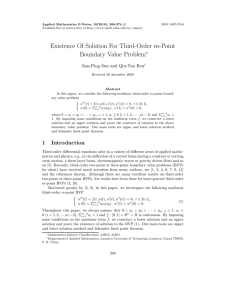HEIKKIL ARGUMENTS ttAND VALUE
advertisement
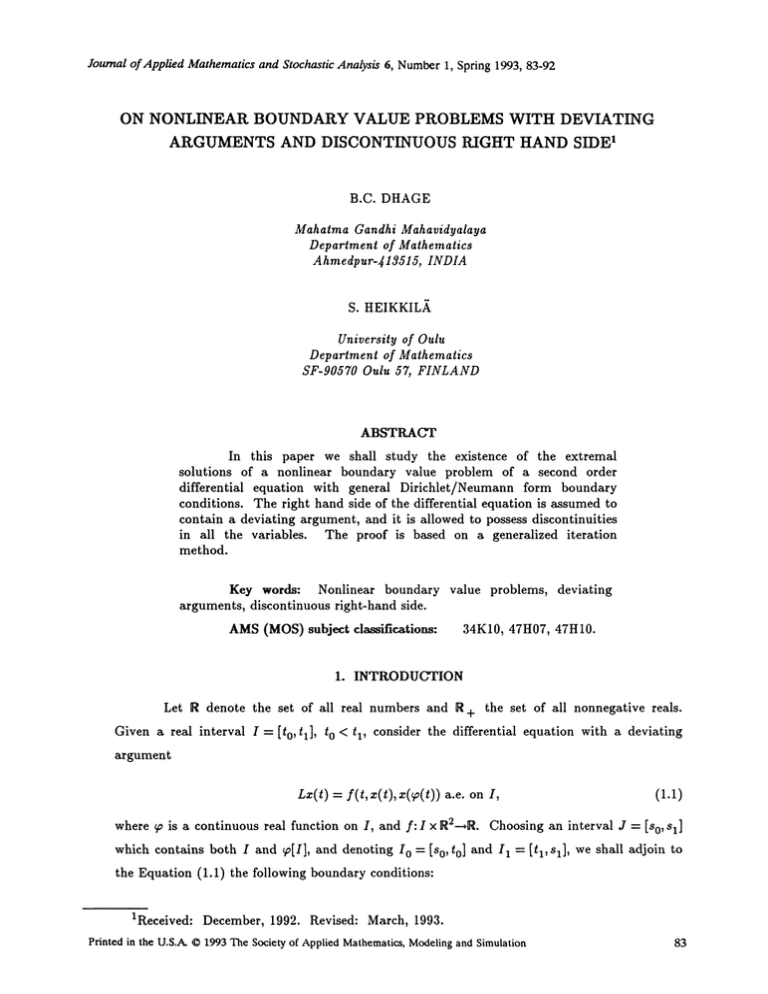
Journal of Applied Mathematics and Stochastic Analysis 6, Number 1, Spring 1993, 83-92
ON NONLINEAR BOUNDARY VALUE PROBLEMS WITH DEVIATING
ARGUMENTS AND DISCONTINUOUS RIGHT ttAND SIDE1
B.C. DHAGE
Mahatma Gandhi Mahavidyalaya
Department of Mathematics
Ahmedpur-413515, INDIA
S.
HEIKKIL
University
of Oulu
Department of Mathematics
SF-90570 Oulu 57, FINLAND
ABSTILkCT
In this paper we shall study the existence of the extremal
solutions of a nonlinear boundary value problem of a second order
differential equation with general Dirichlet/Neumann form boundary
conditions. The right hand side of the differential equation is assumed to
contain a deviating argument, and it is allowed to possess discontinuities
in all the variables. The proof is based on a generalized iteration
method.
Key words: Nonlinear boundary value problems, deviating
arguments, discontinuous right-hand side.
AMS (MOS) subject classifications:
34K10, 47H07, 47H10.
1. INTRODUCTION
Let R denote the set of all real numbers and
Given a real interval I
= [t0, tl],
R+
the set of all nonnegative reals.
o < tl, consider the differential equation with a deviating
argument
Lx(t) = f(t,z(t),z((t)) a.e.
on
I,
(1.1)
where 9 is a continuous real function on I, and f:I x R2R. Choosing an interval J = [s0,sl]
which contains both I and [I], and denoting I o = [So, t0] and I 1 = [tl, S] we shall adjoin to
the Equation
(1.1) the following boundary conditions:
1peceived: December, 1992. Revised: March, 1993.
Printed in the U.S.A. (C) 1993 The Society of Applied Mathematics, Modeling and Simulation
83
84
B.G. DHAGE and S.
HEIKKII.
Bjx(t) = ajx(t)-(- 1)3bjx’(t) = aj(t),
E Ij, j = 0,1,
where
(i)
aj, bj
The operator
(ii)
gt +, aj + bj
> 0, and cj
LI(Ij), j = 0, 1.
L:ACI(I)---LI(I) has the form
Lx = -x" + px’ + qx, where p, q L(I) and q is positive-valued.
A function x C(J) is said to be
a lower solution of the
BVP (1.1)- (1.2) if its first
derivative exists and is absolutely continuous on I, and if
Lx(t) < f(t, z(t), x((t)) a.e. on I, and Bjx(t) < aj(t),
C I j, j = 0, 1.
x is called an upper solution of
equalities hold in
In the
(1.1)-(1.2) if the reversed inequalities hold
(1.3), we say that x is a solution of (1.1)- (1.2).
case when
f
is zero function, the problem
which we denote by z. In the special case when
the problem
(1.1)-(1.2) has
(1.1)-(1.2) has
(1.3)
in
(1.3). If
a unique solution
f is a function of alone, it can be shown that
at most one solution in the class
AC(I).
The existence of the
solution is guaranteed by the above regularity and boundary conditions, and can be extended
via boundary conditions to a unique solution of (1.1)- (1.2) in the sense defined above.
(1.1)-(1.2) is discussed in
[1, 2] by using classical comparison and iteration methods, and assuming that f is a continuous
The existence and uniqueness of the solution to problem
function in all its three arguments.
Recently, the existence of extremal solutions to the BVP
(1.1)-(1.2)
special case without deviating arguments, but allowing
is studied in
[3] in the
discontinuous nonlinearity for f, by using a generalized iteration method. In the present paper
(1.1)-(1.2)
between given lower and upper solutions via a generalized iteration method developed in [3, 4],
and a comparison method. The function f is required to be continuous only at the points
(tj, x,y), j = O, 1.
we shall study the existence of the extremal solutions of the general problem
2. PRELIMINARIES
Let C + (J) denote the space of all nonnegative-valued functions of C(J). We assume
that the space
C(J)
is endowed with the norm
1[ [[ 0 and with the partial ordering <
defined
by
II x II 0
If, a, b
max
tEJ
x(t)
< y if and only if x(t) < y(t) for all t E J.
and x
C(J), denote [a, b]- {x C(J)
a
<_ x <_ b}.
(2.1)
Constructive Method for Solving a Nonlinear Singularly Perturbed System
85
We shall impose the following assumptions on the function f: I x 2---[R:
(f0) The BVP (1.1)-(1.2) has a lower solution a and an upper solution b such that
a<b.
(fl)
(f2)
f(., z(. ), y(- )) is measurable for all
There exists h E
L(I)
, y e [a, b].
such that (,y)--f(t,z,y)/h(t): is nondecreasing in
e
(f3)
f
is continuous at
(tj,,y)
for all :
e [a(tj),b(tj)]
and y
[a((tj)),b((tj))],
j=O, 1.
(f4)
The functions f(., a(. ), a((. )) and f(., b(. ), b((. )) are Lebesgue integrable.
Consider now the BVP
(t) = g(t,y(t),y((t)) a.e.
on
I, Bj(t)
aj(t),
.
I:i
j
0,1,
where
= Lz + h(t): and g(t,z,y) = f(t,z,y) + h(t)z.
(2.3)
[a, b], it follows from (fl), (f2) and (2.3) that g(., y(. ), y((. )) is measurable on
I, that both g(., a(-), a((. )) and g(., b(. ), b((. )) are Lebesgue integrable on I, and that
If y
g(t,y(t),y((t)) <_ M(t) for a.a. t I,
where
M(t) = 2 g(t,a(t),a((t)) + g(t,b(t),b((t))l, t I.
(2.4)
Hence, the equation
1
Fy(t) =
/k(t,s)g(s,y(s),y((s)))ds,
t
I,
to
where k(t,s) is the Green’s function associated with the operator
boundary conditions
ajFy(t:i
1)JbjFy(t:i
and the homogeneous
O, j = O, 1,
C(I) for each y e [a, b]. Since q + h q C + (R),
maximum principle that k(t, s) is nonnegative on I x I.
defines a function Fy
it follows from the
Employing the Green’s function and superposition principle for ordinary linear
differential equations, one can show that the BVP
which can be expressed in the form
(2.2) has for each y [a, b] a unique solution
B.G. DHAGE and S. HEIKKII_
86
Fy(t)
x(t) = Gy(t) = z(t) +
tIj, bj#O,j=0,1
b1
t E I j,
0,
The operator G, defined
Lemma 2.1:
satisfies a < Ga and Gb < b.
on
b1 = 0, j = 0, 1.
[a,b] by (2.7),
is nondecreasing and
[a,b], x < y be given. From the definition of g given by (2.3)
and from (f3) it follows that (u, v)g(t, u, v) is nondecreasing in [a(t),b(t)] x [a((t)),b((t)] for
a.a. t q I. Noticing also that k is nonnegative-valued, it follows from (2.5) that
Let x,y
Proof:
t1
Fx(t) =
/ k(t,s)g(s,x(s),x((s)))ds
to
tl
<
/k(t,s)g(s,y(s),y(o(s)))ds = Fy(t), t
I.
to
This and
(2.7) imply that Gx g Gy.
(fl) a lower solution of the BVP (1.1)- (1.2), it is also a lower solution
of the BVP (2.2) with y = a. By using this, the maximum principle (cf. [5]) and the definition
of G, it can be shown that a g Ga. Similarly, since b, as an upper solution of (1.1)- (1.2), is
Since a, is by
also an upper solution of (2.2) with y
b, it follows that Gb <_ b.
The proof of our main result will be based on the following lemma, which can be
proved by a generalized iteration method (cf. [3, 4]).
Lemma 2.2:
Let [a,b] be
X, and G: [a, b]--[a, b]
nonempty order interval in an ordered Banach space
a
a nondecreasing mapping.
converges, then G has the least fixed point
x.
x, = min{y [a, bl Gy <_ y},
If
each monotone sequence in Gin, b]
and the greatest fixed point x*. Moreover,
max{vy [a,b] y <_ Gy}.
(2.s)
3. EXISTENCE OF THE EXTREMAL SOLUTIONS
We are now ready to prove the following result concerning the existence of the
extremal solutions of the BVP (1.1)- (1.2) in [a,b].
Constructive Method for Solving a Nonlinear Singularly Perturbed System
If
Theorem 3.1:
(1.1)-(1.2) has
87
(f0)-(f4) hold, then
the order interval [a,b].
the hypotheses (i), (ii) and
the least and the greatest solution in
the B VP
(f0). From Lemma 2.1 it follows that
(2.7) defines a nondecreasing mapping G: [a, b]--[a, b]. In view of (2.3), (2.5) and (2.7) we have
for each y E [a, b]
Let a,b E C(J) be
Proof:
as in condition
Gy(t)--Gy(T)I <_ z(t)- z(T)
/
w(t)w(T)l, y e [a,b], t," E J,
where
1
f k(t,s)M(s)ds,
::vp(aj(tbi to})( Fa(tj)
o(t) =
q-
O
= O, 1
tE
Ij, bj
tE
Ij, bj = O,j O, 1.
O,j
(3.2)
Let (Zn)= o = (GYn)= o be a monotone sequence in G[a, b]. Since G[a, b] g [a, b],
then (GYn(t))= o is for each t J a monotone sequence in [a(t),b(t)]. Thus
z(t)- lrnooGYn(t
exist in
From (3.1) it follows that the sequence (GYn)
in
(3.3)
[a(t),b(t)] for each t E J.
(3.3)
n=o is equicontinuous, whence the convergence
is uniform, in particular, the limit functions z of (Gy,)= o belongs to
C(J).
The above proof shows that the hypotheses of Lemma 2.2 hold when X = C(J),
endowed with the norm and the partial ordering defined in (2.1), whence G has the least fixed
point z. and the greatest fixed point :*. In view of the definition of G, both these fixed points
are solutions of the
of the BVP
BVP (2.2) with y = z. This and (2.3) imply that
z. and z* are solutions
(1.1)-(1.2)in [a,b].
(1.1)-(1.2), then it satisfies the BVP (2.2) with y = z,
point of G. Since z. and z" are the least and the greatest fixed points of
If z E [a,b] is a solution of
whence z is a fixed
G, then
z. _< z < z*.
Thus,
z.
and z* are the least and the greatest solutions of the BVP
(1.1)-(1.2) in [a,b].
,
(f0) and (f4) can be replaced by the following growth condition:
If(t,x,y) <_ H(t, Ix I, yl) for all t E I\Z and for all x,y E where Z is a
null set in I, H:I xR2+ R +, I-I(t,u,v) is nondecreasing in (u,v) for all t E I\Z,
The conditions
(f5)
and the BVP
Lx(t) = H(t,x(t),x((t)) a.e. on I, Bjz(t) = c/(t) I,
t
Ij, j = 0, 1
(3.4)
B.G. DHAGE and S.
88
HEIKKIL
has an upper solution in C + (J).
Prolmifion
a
=
w, b
= w,
If f:I x R2---,R satisfies condition (fh), then condition (f0) holds for
C + () is an uer solution of (3.4). If conditions (fX)- (f3) hold
BVP (1.1)-(1.2) has the eztremal solutions in the order interval
;I.1:
where w
with these a,b, then the
Let w
Proof:
C+ (J))
be an upper solution of the BVP
(3.4). From (t5)
it
follows that
.p{ If(t,,y)l
I1 _< w(t),
lyl _< w(,(t))} _< H(t,w(t),w((t))) <_ Lw(t) for a.a. t E I.
(3.5)
This implies that
L(- w)(t) < f(t, -w(t), -w((t))) and f(t, w(t), w((t))) < Lw(t) a.e. on I.
Because
ajw(tj)- (- 1)’bjw’l(tj) >_ 1%(t) I,
t
I, j = 0,1,
it follows that
ajw(tj)- (- 1)Jbjw’(tj) > aj(t), and aj(- w)(tj)- (- 1)Jbj(- w)’(tj) < aj(t), EIj,
j- O, 1.
(f0) holds with a = -w and b = w. If conditions (fl)-(f3) hold with these a,b, it
follows from (3.5) and (fl) that also condition (f4) holds. Then the BVP (1.1)-(1.2) has by
Theorem 3.1, the extremal solutions in the order interval [-w, w].
Thus
The existence of the least and the greatest of all the solutions of the BVP
is ensured if the condition
(f6)
(f0)
(1.1)- (1.2)
is replaced by
<- Pl(t)
+ P2(t)
I\Z and for all x,y E R, where Z
is a null set in I, Pi E
(I), i= 1,2, and r(Q)< 1, where r(Q) is the spectral
radius of the operator Q: C(J)--,C(J), defined by
f(t,z,Y)
x
Y
for all t E
LI+
1
f k(t,s)(Pl(S)w(s) + P2(S)W((s)))ds
o
Qw(t) =
fa:i(
0
E Ij, b:i =/: O,j = O,1
E I:i, bj = 0, j = 0, 1.
It is easy to see that (3.6) defines a bounded, linear and nondecreasing operator
Constructive Method for Solving a Nonlinear Singularly Perturbed System
89
Q: C(d)--,C(J). Thus the norm of Q has the following representations:
I! Q II = o
I
II II 0 x
Qv I 0 =
I
!1 o = maxe .Qe(t),
where e denotes the constant function e(t)--_ 1. Each iterate Qn of Q is also bounded, linear
and nondecreasing, whence the spectral radius of Q can be given by
lira (maxlQne(t)) = inf
r(Q) = n.--*oo"
E
n
N
rataIQne(t)).
In particular, r(Q) < 1 if and only if there exists n E N such that Qne(t) < 1 for each t E J.
Proposition 3.2:
a
w, b = w, where w
If f: I R2R satisfies condition (f6),
6’ + (J) is the solution o the B VP
Lw(t) = pl(t)w(t) + pz(t))w(o(t))
If conditions (fl)-(f3)
I,
(f0) holds for
BiT(t) = cj(t) l, t e I,/, j = 0, 1. (3.7)
hold with these a, b, then the BVP
greatest solutions, and they belong to the
Proof:
a.e. on
then condition
(1.1)-(1.2) has
order interval[-w, w].
Denoting by y the solution of (3.4) with H
the least and the
0, the condition r(Q)< 1
ensures that the Neumann series
n0
converges in
C+ (J)
uniformly, and that the sum function w is the solution of the operator
equation
w
= y + Qw.
(3.9)
From the choice of y and from the definition of Q it follows that w is the solution of the BVP
(3.7). Thus condition (fh) holds with H(t,u,v)= pl(t)u + p2(t)v, which implies by Proposition
3.1 that (f0) holds with a=-w and b-w. Hence, if (fl)-(f3) hold, then the BVP
(1.1)- (1.2) has by Proposition 3.1 the extremal solutions in [--w, w].
If z is any solution of the BVP
(1.1)-(1.2),
(f6) that is a lower
solution (3.10). This implies by the maximum principle (cf. [5]) that r < w. Similarly, it can
be shown that : > -w. Thus the extremal solutions of (1.1)- (1.2) in [-w, w] are the least
and the greatest of all the solutions of (1.1)- (1.2).
it follows from
(fl) holds, for instance if f coincides
measurable function in D = {(t,z,y) a(t) < z < b(t), a((t)) < y < b((t))}.
Remark 3.1:
Condition
a.e. to a Borel
The above results can be extended naturally with the same techniques for problems
90
B.G. DHAGE and S.
HEIKKILA
(1.1)
involving several deviating arguments, i.e. where Equation
is replaced by
Lx(t) : f(t,x(t),x(l(t)),...,X(m(t)) a.e. on
4. AN
-
Let C j,
Cj (n +
q- 1 j
j= 1,2,3,
e N}.
be
(3.10)
EXAMPLE
nonempty
Define g j: R--,R, j
.
well-ordered
sets
in
[1/2,1),
for
instance
1, 2, 3, by
z,
[O, minCj)U[1,c),
e [minCj, 1),
zG
gj(z) = min{y Cj U {1}1 < y},
(4.1)
I-g(-=),
It is easy to see that each gj is nondecreasing and discontinuous at each point of Cj.
Moreover, g(z) < 2lz for each z E R..
j
PJeL7(I),
I=[-1,1], and let
Choose
= 1,2,3} <_ 0.74 and gj(t)--,O as t---,- 1 +
j
= 1, 2, 3,
satisfy
max{ess sup pj
or t--,1-.
Consider the boundary value problem
x"(t) = f(t,x(t),x(t- 1),x(t + 1)), a.e. on I, x(t) = 1, t [- 2,
1] U [1,2],
where
f(t,x,y,z) = Pl(t)gl(x) q- p2(t)g2(y) q- P3(t)g3(z), e I, x,y,z
.
(4.2)
(4.3)
It is easy to show that the function f satisfies conditions (fl)- (f3). Moreover,
If(t,z,y,z)l _< 1.48(1:1
+ Ivl
/
Izl), a.e.
on
I.
(4.4)
Choosing J = [-2, 2], define an operator Q: C(J)C(J) by
1
Qw(t) =
1.48 f
O,
-1
k(t,s)(w(s) + w(s 1) + w(s + 1))ds
tel,
tel-2,- 1] tJ [1,21,
where
(1
k(t,$) =
t)(1 + s)
2
(1 d" t)(1 s)
2
-1 <_s<_t<_l,
(4.6)
-l<t<s<l.
It can be shown (cf. [2]) that r(Q)< 1. Thus f satisfies also the hypothesis (f6),
whence the BVP (4.2) has by Proposition 3.2 and Remark 3.1 the least and the greatest
solution, and that all the solutions of (4.2) belong to the order interval [-w, w], where w is the
Constructive Method for Solving a Nonlinear Singularly Perturbed System
91
solution of the BVP
w"(t) = 1.48(w(t)+ w(t- 1)+ w(t + 1)), t I,
w(t)
1, t e [---2,-- 1]U[1,2],
REFERENCES
[11
tteikkil/i, S., Mooney, J.W., and Seikkala, S., Existence, uniqueness and comparison
results for nonlinear boundary value problems involving a deviating argument, j.
Differential Equations 41, 3 (1981), 320-333.
[2]
Heikkil/i, S., On well-posedness of a boundary value problem involving deviating
arguments, Funkcialaj Ekvacioj 28, 2 (1985), 221-232.
[3]
Heikkil/i, S., On fixed points through a generalized iteration method with applications to
differential and integral equations involving discontinuities, Nonlinear Analysis 14, 5
(199), 413-426.
[4]
Heikkil/i, S., Lakshmikantham, V., and Sun, Y., Fixed point results in ordered normed
spaces with applications to abstract and differential equations, J. Math. Anal. Appl.
163, 2 (1992), 422-437.
Protter, M.H. and Weinberger, H.F., Maximum Principles in Differential Equations,
Prentice-Hall, Englewood Cliffs, N.J. 1967.
